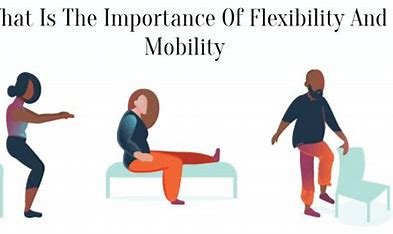Flexibility and mobility are often used interchangeably, but they refer to slightly different concepts, both of which are important for overall physical health, athletic performance, and injury prevention.

Flexibility
Flexibility refers to the ability of a muscle or group of muscles to stretch and lengthen through a full range of motion. It primarily focuses on the muscle-tendon system, allowing muscles to stretch and relax.
Benefits of Flexibility:
- Injury Prevention: Improved flexibility can reduce the risk of strains and sprains by helping muscles and joints handle the stresses of daily movements or physical activity.
- Improved Posture: Stretching muscles that are tight or imbalanced can help correct poor posture, making it easier to stand and move with proper alignment.
- Increased Muscle Function: Flexible muscles work more efficiently, which can help improve performance in athletic activities.
- Reduced Muscle Soreness: Stretching post-exercise can help alleviate muscle tightness and discomfort, aiding recovery.
How to Improve Flexibility:
- Static Stretching: This involves holding a stretch for 20–30 seconds. It’s best done after a workout or physical activity when the muscles are warm.
- Examples: Hamstring stretches, quadriceps stretches, calf stretches, shoulder stretches.
- Dynamic Stretching: This involves moving the muscles through a full range of motion. It’s ideal before a workout to prepare muscles and joints for activity.
- Examples: Leg swings, arm circles, torso twists, walking lunges.
- Yoga or Pilates: These practices focus on improving flexibility by combining stretches with breathing techniques and body awareness.
- Foam Rolling or Self-Myofascial Release: Using a foam roller or other tools to massage the muscles can release tight spots and improve muscle length and flexibility.
Mobility
Mobility refers to the ability of a joint to move freely through its full range of motion, and it involves the coordination between muscles, tendons, ligaments, and bones to ensure smooth, unrestricted movement. Unlike flexibility, which focuses on muscles, mobility also involves joint function and stability.
Benefits of Mobility:
- Joint Health: Maintaining good mobility helps keep the joints lubricated and functioning properly, reducing the risk of joint stiffness or degenerative conditions like osteoarthritis.
- Enhanced Athletic Performance: Good mobility allows for more fluid and efficient movements, which can enhance performance in a wide range of sports and activities.
- Reduced Risk of Injury: Adequate mobility helps to ensure that your body moves properly during physical activity, reducing the likelihood of compensatory movements that may cause injury.
- Better Functional Movement: Mobility is essential for performing everyday tasks, such as bending, lifting, reaching, and squatting, with proper form and minimal strain.
How to Improve Mobility:
- Joint Mobility Drills: These involve controlled, intentional movements that help improve the range of motion in specific joints.
- Examples:
- Hip circles or leg swings to improve hip mobility.
- Ankle circles to improve ankle mobility.
- Shoulder circles and dislocates with a band or PVC pipe to improve shoulder mobility.
- Examples:
- Dynamic Stretching: Dynamic stretching not only improves flexibility but also enhances joint mobility by moving joints through their full range of motion. This includes exercises like:
- Lunges: Improve hip and ankle mobility.
- Torso twists: Improve spine and shoulder mobility.
- Arm swings: Improve shoulder and thoracic spine mobility.
- Strengthening the Muscles Around the Joint: Building strength and stability in the muscles around a joint helps improve mobility by supporting proper movement patterns and reducing stiffness.
- Examples: Squats, lunges, shoulder presses, deadlifts, and planks all help improve joint stability and mobility.
- Active Range of Motion (AROM) Exercises: These exercises involve moving your joint through its full range of motion while using the surrounding muscles. AROM helps increase mobility while also developing muscle strength.
- Examples: Controlled shoulder raises, hip rotations, or knee extensions.
- Foam Rolling or Soft Tissue Work: Like flexibility, foam rolling can also help improve mobility by releasing tightness in the muscles and fascia around joints, allowing for smoother movement.
The Difference Between Flexibility and Mobility:
- Flexibility is about the muscle’s ability to lengthen and stretch.
- Mobility is about how well a joint moves through its full range of motion, supported by muscles, tendons, ligaments, and bones.
While flexibility is an important part of mobility, mobility also involves joint stability, strength, and control. For example, you may have flexible hamstrings but still struggle with hip mobility if the hip joint doesn’t move through its full range of motion due to tightness or weakness around the joint.
Why Both Matter:
- Flexibility ensures that muscles can elongate and stretch, preventing stiffness and promoting fluid movement.
- Mobility ensures that joints can move freely and properly, allowing for proper alignment, reduced pain, and optimal performance during both everyday movements and physical activities.
Sample Routine for Improving Flexibility and Mobility:
- Hip Mobility (3–5 minutes)
- Hip Circles: 10 reps per direction.
- Lunges with a Twist: 10 reps per side.
- Shoulder Mobility (3–5 minutes)
- Arm Circles: 10 reps forward, 10 reps backward.
- Shoulder Dislocates (with a resistance band or PVC pipe): 10–15 reps.
- Spinal Mobility (3 minutes)
- Cat-Cow Stretch: 10 reps.
- Thoracic Spine Twists: 10 reps per side.
- Hamstring Flexibility (3–5 minutes)
- Standing Hamstring Stretch: Hold for 20–30 seconds per leg.
- Dynamic Hamstring Stretch: Leg swings (forward and backward), 10–15 reps per leg.
- Ankle Mobility (2–3 minutes)
- Ankle Circles: 10 reps per direction.
- Lunge with Heel Lift: 10 reps per leg.
Conclusion:
Incorporating both flexibility and mobility work into your routine will significantly improve your overall movement quality, reduce the risk of injury, and enhance athletic performance. Flexibility will allow you to stretch muscles effectively, while mobility will ensure that your joints function optimally, allowing for fluid and efficient movements. Both are crucial for maintaining balance, strength, and mobility in daily life and exercise.
